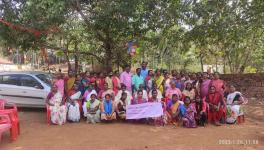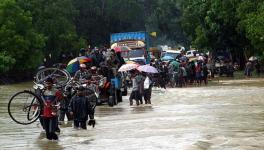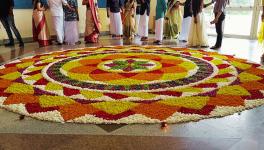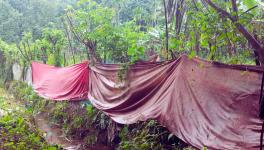Kerala: These Women Make Environmentally Destructive Water Hyacinths into Income Ideas
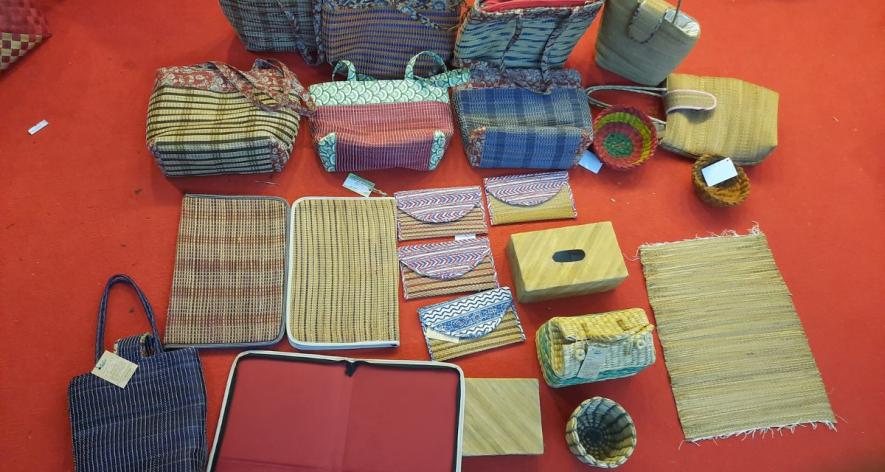
Thrissur/Alappuzha: The workstation of Kottappuram Integrated Development Society (KIDS) in the Thrissur district of Kerala is a mess of plastic wires at a glance. On a closer look, it becomes evident that the women here are dealing with dried water hyacinths and palm leaves. These women from the town bordering Ernakulam district have been earning a livelihood by making home decor items from eco-friendly raw materials.
Launched in 1987, KIDS has been creating products from palm leaves and screw pines by weaving and using looms. The traditional knowledge of processing innovative products reached its helm when the women workers explored the hidden potential of water hyacinths in 2005. They were the first in India to introduce a loom system for creating products from dried hyacinth stems.
“Technology has brought about changes, but sound knowledge of traditional practices is our core strength. Around 600 women reap benefits by collecting, cleaning, drying, or making products from screw pines, palm leaves and water hyacinths. Of them, 150 exclusively deal with hyacinths. All are members of local Kudumbashree units,” said Fr Paul Thomas Kalathil, Executive Director of KIDS.
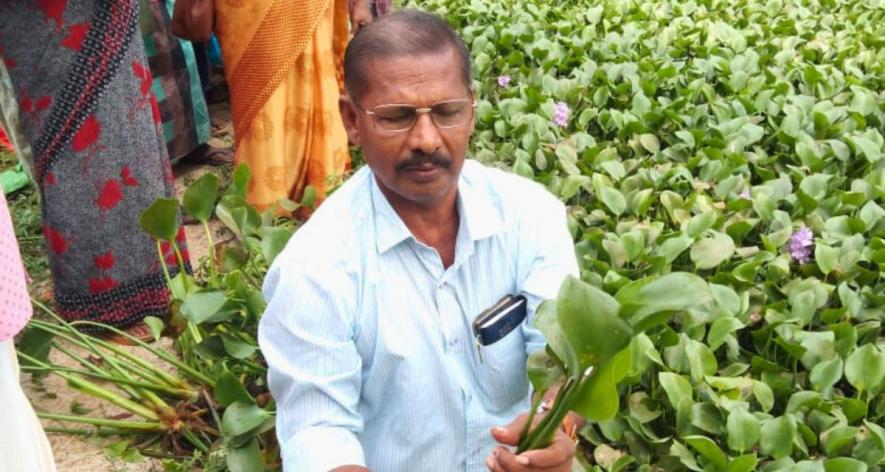
When they get several orders at a time, they double the workforce by temporarily employing women from neighbouring villages, thus transforming the stems into ladies’ handbags and purses, file folders, tissue paper boxes, table and flower pots, table and floor mats, and small baskets.
Vimala Jose (60) from Kara in Thrissur district has been associated with KIDS for the last 22 years. “In the initial stages, we faced challenges in the collection and drying of stems and the dyeing process. However, traditional knowledge and expert training guided us... Even during the COVID-19 period, we did not face a shortage of orders," Jose told 101Reporters.
According to Jose, they have four action groups. The first one, based in villages, will collect hyacinths from water bodies, segregate stems and forward them for drying. The second group is involved in dyeing the stems with various natural colour variants, while the third converts them into flexible materials using looms. The fourth group makes finished products. There is a fifth group taking up sales initiatives at pavilions and exhibitions.
KIDS has an e-commerce website and permanent sales pavilions, one of which is at Muziris Heritage Town, a few km from Kottappuram. Even for setting up sales pavilions and field activities, KIDS sticks to a community–participation approach.
PPP model
Neelamperoor panchayat in Alappuzha district has a public-private partnership (PPP) model for water hyacinths with Rope Enterprises Private Limited, a Madurai-based startup. Initially, Rope Enterprises collected hyacinths from Kainakary through local workers/contractors, but the strategy did not work well.
They connected with Haritha Kerala Mission (HKM) through contacts, which paved the way for hyacinth collection from Alappuzha municipal area in early 2022. As Rope Enterprises needed large quantities, HKM connected the company with Neelamperoor panchayat by year-end. Rope Enterprises collects hyacinths based on their requirement, mostly every three to four months.
"Nearly 300 women, including Kudumbashree members and MGNREGA workers, got substantial benefits. The full amount goes to them, the panchayat does not claim any of it,” Neelamperoor village panchayat president TK Thankachan told 101Reporters. Now, more panchayats have approached HKM for similar revenue-generating projects.
“We will expand to more panchayats, but nothing has been finalised yet,” said Sreejith Nedumpally, co-founder and managing director of Rope Enterprises, which pays Rs 10 per kg for dried hyacinth stems and Rs 7 for fresh ones.
“Earlier also, we got enquiries for small quantities, and we supported them. Prior to Neelamperoor, PPP was implemented in the canals of the Alappuzha municipal area,” T N Seema, a former Rajya Sabha member and HKM state coordinator, told 101Reporters.
The biggest challenge is to dry up the hyacinths in monsoons, as the rainy season lasts for several months in Kerala. Unlike in Alappuzha, Neelamperoor does not have a ground where they can dry it. On many occasions, the buyer is forced to collect fresh hyacinths (90% water) for a high price. “We prefer dried stems,” said Nedumpally. Rope Enterprises employs over 300 women in its Tamil Nadu unit.
A double-edged sword
Water hyacinths may have brightened the lives of several women in both states, but their ill effects on the environment cannot be disregarded. Every year, the Irrigation Department and local bodies in Kerala spend substantial amounts to remove hyacinths, a hazardous waste that severely damages the quality of water bodies.
Earlier, when a majority of the rural population was engaged in agriculture, people used to clear it regularly. With the changing times, hyacinth has been gobbling up water bodies so much that they affect agriculture, fishing, inland navigation and tourism. Mosquitoes breed in them, increasing the risk of malaria and dengue fever.
A leading tour operator in Changanassery town, Sabu Thomas (55), said hyacinths impeded the natural flow of excess water during rains, triggering flash floods. “Aquatic weeds have a fast growth rate and multiple modes of reproduction channels. With their thick-hard roots connected to each other, they can divert the flow, especially in small canals,” observed K Omanakuttan (50), a duck farmer from Nedumudi.
Water hyacinths in large quantities even block sunlight and oxygen, choking fish habitations and affecting local breeds. For clearing purposes, JCB earthmovers have to be employed. “Kulavazha [Eichhornia crassipes] and Kadakal [a local breed that is like a secondary growth on hyacinths] are nightmares of boat drivers. Sometimes they get tangled on the propellers, and boatmen have to dive in to clear it out,” he added.
“Some customers prefer to go to interior villages to explore the inland waterways and life. With the routes cleared now, country boat rides to those scenic villages are possible,” attested Thomas.
Seema claimed the initiative helped local panchayats to save some funds that were supposed to be spent on clearing hyacinths. However, one may wonder if it is a permanent solution as water hyacinths should grow back if the women have to benefit. In addition, the fact remains that it is not possible to remove the highly invasive species fully, even using JCBs. There have been several instances across Kerala where the plant was removed only to see it grow back in no time.
Checking out some historical facts may help understand its harmful traits. Water hyacinths presumably arrived from Southeast Asian countries and initially floated in the rivers and lakes of the Bengal region, as Lady Warren Hastings, the wife of Warren Hastings, the first British Governor General of Bengal, had a special fondness for its violet and white flowers. But it soon invaded the water bodies across the country. Maybe due to its ability to trigger regional floods, it earned the sobriquet ‘Bengal Terror’.
An uptick in innovation
This November, the Southern Bench of the National Green Tribunal asked the Department of Environment to submit a detailed report on the plans to check the menace of water hyacinths that have spread out in several water bodies across the state.
Besides the government-backed projects, there are other new models of utilising hyacinths. Two years ago, SP Sujith Swami Nikarthil, a farmer in his 30s from Alappuzha district, came up with a unique way. “In Vembanad Lake, just a few hundred meters from Kannankara Boat Jetty, a floating waterbed was created with five tonnes of hyacinths piled together in a 10 x 6 m area. The water-intensive bandi [marigold category] was planted on it,” Nikarthil, who has a huge fan following on his social media page Variety Farmer, told 101Reporters.
The result of the model was astonishing as bandi flowers bloomed in a couple of weeks. The platform can be used for cultivation three to four times and subsequently serve as a biofertiliser. “The garden attracts tourists, wedding photographers and agricultural enthusiasts, which indirectly benefits local traders,” said Vimal Kumar (46), a Kannankara native.
Nikarthil said the model could be replicated in the households of every backwater village to cultivate select local varieties such as cheera (spinach).
Besides individual efforts, there are team efforts as witnessed at EichhoTech, a student startup incubated at the Sanathana Dharma (SD) College, Alappuzha, exclusively for strengthening the research and development aspects of water hyacinths. “All components and elements of water hyacinths such as leaves, stalks, roots, stems and flowers are useful,” Dr G Nagendra Prabhu, Principal Investigator, Centre for Research on Aquatic Resources (CRAR), and Head of Department of Zoology at SD College.
Drawing from his 25 years of experience, he serves as the mentor for the five-member EichhoTech team. The CRAR developed the technologies for utilising water hyacinths through decades of research. EichhoTech fine-tuned some of them to make consumer market-oriented products and customised gifts.
The team discerned that hyacinths could be useful for making handicrafts, natural dye for drawing canvas, disposable plates and glasses, coasters, nursery pots, pen stands, partition boards, file boards, sculptures/statues, writing pads, handbooks, table calendars, wedding invitation, greeting cards, puppets, Christmas cribs, bookmarks, eco-friendly rakhis, lamp shades and mats.
Hyacinth stalks have a countrywide potential as an organic feed for farm animals and poultry. Multiple colour variants can be generated from their flowers, a potential natural dye for the textile industry. “Along with research, we have been training rural communities, local bodies, NGOs, students and young entrepreneurs,” Anoop Kumar V, founder and CEO of EichhoTech, told 101Reporters.
Corporate Social Responsibility (CSR) wings of major corporations could play a role in boosting the market presence of water hyacinth products. “CSR arms of Wipro and Hyundai Motor India support our activities,” said Fr Kalathil. Anoop said they also got enquiries, but nothing has materialised so far.
Nevertheless, decision-makers are a little hesitant to act. “We held several rounds of discussion regarding production units, but it is not feasible at present. The government bodies/agencies have limitations in taking up projects that require huge infrastructure and a large number of regular employees. At present, we prefer to support buyers,” Seema affirmed.
If more funds from Central initiatives such as Make In India and Atmanirbhar Bharat are allocated, it would strengthen the stakeholders' efforts. The initiative can then bloom into a successful business model, as seen in Vietnam, Cambodia and Thailand.
Once, the coir industry played a significant role in rural Kerala’s commercial landscape. Water hyacinths, if utilised productively, could emerge as another prominent commercial activity.
(Jaijith James is a Kerala-based freelance journalist and a member of 101Reporters, a pan-India network of grassroots reporters.)
Get the latest reports & analysis with people's perspective on Protests, movements & deep analytical videos, discussions of the current affairs in your Telegram app. Subscribe to NewsClick's Telegram channel & get Real-Time updates on stories, as they get published on our website.










